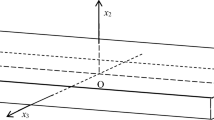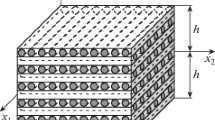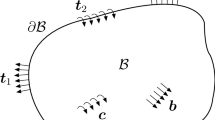Abstract
This communication aims to initiate an investigation towards understanding the influence that fibre bending stiffness has on the three-dimensional dynamic behaviour of fibrous composites with embedded functionally graded stiff fibres. In this context, it (i) formulates the general dynamical problem of a rectangular plate with embedded a single family of straight fibres that possess bending resistance and are distributed in a controlled, functionally graded manner through the plate thickness, and (ii) for simple support boundary conditions, it solves the free relevant vibration problem. The problem formulation is based on principles of polar linear elasticity and leads to a high-order set of Navier-type partial differential equations with variable coefficients. For simply supported edge boundaries, solution of these equations is achieved with the use of a computationally efficient semi-analytical (so-called fictitious layer) mathematical method. Two types of possible inhomogeneous distributions of straight fibres are considered for computational and numerical result presentation purposes. These are both regarded as possible, realistic types of inhomogeneous redistributions of stiff fibres that in previous studies have been assumed homogeneously distributed throughout the plate body. The presented numerical results examine to a considerable extent the manner that either of the employed types of inhomogeneous fibre redistribution, in conjunction with the fibre ability to resist bending, affects the dynamic behaviour of the fibrous composite plate of interest.




Similar content being viewed by others
References
Adkins JE, Rivlin RS (1955) Large elastic deformations of isotropic materials X. Reinforcement by inextensible cords. Philos Trans R Soc Lond A 248(944):201–223
Rivlin RS (1955) Plane strain of a net formed by inextensible cords. J Ration Mech Anal 4:951–974
Spencer AJM, Soldatos KP (2007) Finite deformations of fibre-reinforced elastic solids with fibre bending stiffness. Int J Nonlinear Mech 42(2):355–368
Soldatos KP (2014) Foundation of polar linear elasticity for fibre-reinforced materials. J Elast 114(2):155–178
Soldatos KP (2015) Foundation of polar linear elasticity for fibre-reinforced materials II: advanced anisotropy. J Elast 118(2):223–242
Dagher M, Soldatos KP (2011) On small azimuthal shear deformation of fibre-reinforced cylindrical tubes. J Mech Mater Struct 6(1):141–168
Farhat AF (2013) Basic problems of fibre-reinforced structural components when fibres resist bending. PhD thesis University of Nottingham
Farhat AF, Soldatos KP (2015) Cylindrical bending and vibration of polar material laminates. Mech Adv Mater Struct 22(11):885–896
Soldatos KP, Aydogdu M, Gul U (2019) Plane strain polar elasticity of fibre-reinforced functionally graded materials and structures. J Mech Mater Struct 14(4):497–535
Pagano NJ (1969) Exact solutions for composite laminates in cylindrical bending. J Comput Mater 3(3):398–411
Srinivas S, Rao AK, Rao CVJ (1969) Flexure of simply supported thick homogeneous and laminated rectangular plates. ZAMM-J Appl Math Mech 49(8):449–458
Srinivas S, Rao AK (1970) Bending, vibration and buckling of simply supported thick orthotropic rectangular plates and laminates. Int J Solid Struct 6(11):1463–1481
Srinivas S, Rao CVJ, Rao AK (1970) An exact analysis for vibration of simply-supported homogeneous and laminated thick rectangular plates. J Sound Vib 12(2):187–199
Soldatos KP, Hadjigeorgiou VP (1990) Three-dimensional solution of the free vibration problem of homogeneous isotropic cylindrical shells and panels. J Sound Vib 137(3):369–384
Soldatos KP, Ye JQ (1994) Three dimensional static dynamic thermoelastic and buckling analysis of homogeneous and laminated composite cylinders. Compos Struct 29(2):131–143
Shuvalov AL, Soldatos KP (2003) On the successive approximation method for three-dimensional analysis of radially inhomogeneous tubes with an arbitrary cylindrical anisotropy. J Sound Vib 259(1):233–239
Ye J (2003) Laminated composite plates and shells. 3D modelling, 1st edn. Springer, London
Brischetto S (2019) Exponential matrix method for the solution of exact 3D equilibrium equations for free vibrations of functionally graded plates and shells. J Sandw Struct Mater 21(1):77–114
Soldatos KP (2020) On the characterisation of polar fibrous composites when fibres resist bending Part III: the spherical part of the couple-stress. Int J Solids Struct 202:217–225
Vel SS, Batra RC (2004) Three-dimensional exact solution for the vibration of functionally graded rectangular plates. J Sound Vib 272(3–5):703–730
Gibson RF (1994) Principles of composite material mechanics. McGraw-Hill, Singapore
Soldatos KP (2009) Towards a new generation of 2D mathematical models in the mechanics of thin-walled fibre-reinforced structural components. Int J Eng Sci 47:1346–1356
Soldatos KP, Watson P (1997) Accurate stress analysis of laminated plates combining a two-dimensional theory with the exact three-dimensional solution for simply supported edges. Math. Mech. Solids 2:459–489
Liu S, Soldatos KP (2002) On the improvement of transverse stress distribution predictions in cross-ply laminated beams: advanced versus conventional beam modelling. Int J Mech Sci 44:287–304
Timarci T, Soldatos KP (2000) Vibrations of angle-ply laminated circular cylindrical shells subjected to different sets of edge boundary conditions. J Eng Math 37(1–3):211–230
Soldatos KP (2003) Accurate stress analysis of laminated composite components. In: Altenbach A, Becker W (eds) Modern trends in composite laminates mechanics. Springer Verlag, CISM, pp 69–132, Courses and lectures no 448 (ISBN 3-211-20302-8)
Author information
Authors and Affiliations
Corresponding author
Additional information
Publisher's Note
Springer Nature remains neutral with regard to jurisdictional claims in published maps and institutional affiliations.
Appendices
Appendix A: Entries of the matrices G, T and \(\varvec{\varGamma }\)
The entries of matrix G appearing in (21) are as follows:
where
The elements of the matrix T appearing in (23) are as follows:
Finally, the entries of matrix \(\varvec{\varGamma }\) appearing in (32) are as follows:
where
Appendix B: On the in-plane distortional modes (0, 1) and (1, 0)
In dealing with the in-plane distortional mode (m, \(n) = (0, 1)\), the displacement field (19) yields
and this enables the equations of motion (12) or, equivalently (14) to reduce to the single equation
Due to the plate inhomogeneity, (B.2) is generally a second-order ordinary differential equation with variable coefficients that can be solved either with standard power-series methods or with the fictitious layer method employed in this communication.
However, in the case of a homogeneous plate, where \(C_{55}\) is constant, (B.2) simplifies further and becomes
The lowest frequency associated with this mode is thus seen associated with the linear mode shape
where A is a constant. This solution of (B.2) returns the natural frequency
which, by virtue of (43), obtains the non-dimensional form
The fact that all \(\varOmega _{01}\)-values illustrated in Tables 1, 2, 3, 4, and 5 for homogeneous plates (\(\varepsilon = 0\)) can alternatively be obtained with direct use of (B.5) verifies the efficiency and correctness of the employed computational code. The latter was naturally used for the evaluation of the remaining of the \(\varOmega _{01}\)-values shown in Tables 1, 2, 3, 4, and 5 for \(\varepsilon \ne 0\). These values clearly demonstrate a small influence that the assumed, top-stiff plate inhomogeneity exerts on the values (B.5) of their homogeneous plate counterparts. Nevertheless, Table 6 reveals that the \(\varOmega _{01}\)-values are influenced more severely from the enhanced inhomogeneity encountered in a through-thickness symmetric fibre redistribution.
Similar observations apply with regard to the in-plane distortional mode (m, \(n) = (1, 0)\), for which the displacement field (19) yields
This enables the equations of motion to reduce to the single equation
which, due to the plate inhomogeneity, is generally again a second-order ordinary differential equation with variable coefficients. It should be noted though that, unlike (B.2), (B.7) is now influenced by resistance that the fibres may exhibit if/when subjected to in-plane bending.
However, in the case of a homogeneous plate, where \(C_{44}\) is constant, (B.7) simplifies further and becomes
The lowest frequency associated with this mode is again associated with the linear mode shape
where B is a constant. This solution of (B.8) returns the natural frequency
and, by virtue of (43), obtains the non-dimensional form
Rights and permissions
About this article
Cite this article
Aydogdu, M., Aksencer, T. & Soldatos, K.P. On three-dimensional dynamics of fibre-reinforced functionally graded plates when fibres resist bending . J Eng Math 128, 13 (2021). https://doi.org/10.1007/s10665-021-10128-0
Received:
Accepted:
Published:
DOI: https://doi.org/10.1007/s10665-021-10128-0




